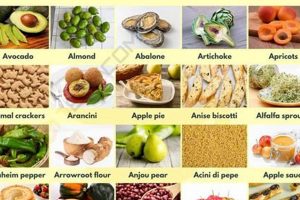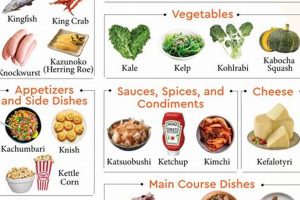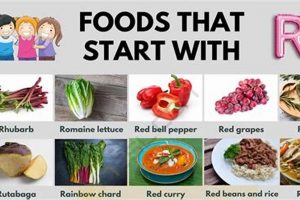The initial development phase for a food product, characterized by activities such as recipe formulation, ingredient sourcing, and preliminary marketing analysis, is a critical juncture. For instance, a company developing a new line of plant-based alternatives undergoes this formative process to define its products and target market.
This nascent stage is vital for securing funding, establishing supply chains, and validating product viability. Historically, robust preparation has been a distinguishing factor between successful food ventures and those that fail to gain traction. Thorough planning minimizes risks and maximizes the potential for long-term sustainability.
The following sections will elaborate on specific areas within this developmental phase, including product development strategies, regulatory compliance considerations, and effective launch methodologies to ensure a positive market reception.
Guidance for New Food Product Development
The effective and strategic launch of a novel food product hinges on diligent preparation and a clear understanding of market dynamics. The following recommendations offer insights for navigating the critical early stages.
Tip 1: Conduct Thorough Market Research: A comprehensive understanding of consumer preferences, competitive landscapes, and potential market gaps is paramount. Failure to adequately assess these factors can lead to misaligned product offerings and wasted resources. For example, analyzing existing health food trends before developing a new granola bar can inform ingredient selection and marketing strategies.
Tip 2: Prioritize Product Formulation and Testing: A well-defined and thoroughly tested recipe is crucial for ensuring consistent quality and consumer satisfaction. Conduct multiple iterations, incorporating sensory evaluations and shelf-life studies to optimize the final product. A poorly formulated product, regardless of marketing efforts, will likely fail to gain sustained market traction.
Tip 3: Establish Robust Supply Chain Management: Secure reliable sources for ingredients and packaging materials to mitigate supply chain disruptions. Negotiate favorable terms with suppliers and develop contingency plans to address potential shortages. Interrupted supply chains can significantly impact production schedules and customer fulfillment.
Tip 4: Navigate Regulatory Compliance: Ensure strict adherence to all applicable food safety regulations, labeling requirements, and industry standards. Non-compliance can result in costly recalls, legal penalties, and damage to brand reputation. Consult with legal and regulatory experts to proactively address these requirements.
Tip 5: Develop a Comprehensive Marketing Strategy: A well-defined marketing plan should target the intended consumer demographic and articulate the product’s unique selling proposition. Utilize a mix of online and offline channels to maximize reach and build brand awareness. Ineffective marketing can render even the best product unnoticed.
Tip 6: Secure Adequate Funding: Sufficient financial resources are essential for covering operational expenses, marketing initiatives, and potential unforeseen challenges. Explore various funding options, including grants, angel investors, and venture capital, and develop a detailed financial plan to demonstrate responsible resource allocation. Under-capitalization is a common cause of failure in new food ventures.
Tip 7: Build a Strong Team: Surround oneself with individuals possessing expertise in areas such as product development, marketing, sales, and operations. A competent and dedicated team can significantly increase the likelihood of success. Identify and address any skills gaps early in the process.
These guidelines emphasize the importance of meticulous planning, diligent execution, and a deep understanding of the food industry landscape. By prioritizing these key areas, entrepreneurs can increase their chances of successfully launching and sustaining a viable food product.
The subsequent sections will delve into more specific aspects of the food product launch process, building upon the foundational principles outlined above.
1. Recipe Formulation
Recipe formulation stands as a foundational pillar within food product development, representing the tangible embodiment of a concept and the initial step toward market realization. Its significance extends beyond mere ingredient combination; it defines the product’s identity, nutritional profile, and overall market appeal. Thorough and strategic formulation is therefore paramount to a successful food venture.
- Ingredient Selection and Functionality
The selection of ingredients directly impacts both the sensory characteristics and the functional properties of the final product. Each ingredient contributes a specific attribute, such as texture, flavor, or binding capability. Careful consideration must be given to the interactions between ingredients, as these can affect the product’s stability, shelf life, and overall quality. For instance, the choice of a specific thickening agent in a sauce formulation can influence its viscosity and mouthfeel, impacting consumer perception.
- Nutritional Profile Optimization
In an increasingly health-conscious market, optimizing the nutritional profile of a food product is crucial. Recipe formulation allows for the strategic manipulation of macronutrient ratios, vitamin and mineral content, and the inclusion of functional ingredients. This involves careful consideration of serving sizes, ingredient sourcing, and potential fortification strategies to meet specific nutritional targets and appeal to health-focused consumers. Example: Adding flaxseed to a bread recipe to boost omega-3 fatty acid content.
- Sensory Evaluation and Consumer Acceptance
The sensory attributes of a food product its appearance, aroma, taste, and texture are primary drivers of consumer acceptance. Recipe formulation must incorporate sensory evaluation at various stages of development to ensure that the final product aligns with target market preferences. This often involves conducting blind taste tests and gathering feedback on different formulations to identify the most appealing sensory profile. For instance, adjusting the sweetness and acidity levels in a fruit preserve based on consumer feedback.
- Scalability and Manufacturing Feasibility
A well-formulated recipe must be readily scalable for efficient manufacturing. Considerations such as ingredient availability, processing equipment limitations, and production time constraints should be integrated into the formulation process. Formulations that are overly complex or reliant on specialized ingredients may pose challenges in scaling up for commercial production. Example: Ensuring that a baking recipe can be easily adapted from a small-batch home recipe to a large-scale industrial process.
Recipe formulation, therefore, is not merely a technical exercise but a strategic imperative that dictates the trajectory of a food product’s success from its initial conception. A meticulous and consumer-centric approach to recipe development is essential for building a foundation upon which a viable and competitive product can be launched.
2. Ingredient Sourcing
Ingredient sourcing, the process of identifying, evaluating, and securing the raw materials necessary for food production, is inextricably linked to the success of any nascent food product enterprise. The decisions made regarding ingredient acquisition directly impact product quality, cost, and sustainability, thus shaping its overall viability within the marketplace.
- Quality Assurance and Traceability
Securing high-quality ingredients from reliable suppliers is paramount to maintaining product consistency and meeting consumer expectations. Effective ingredient sourcing necessitates a robust system for tracking the origin and handling of raw materials. Traceability mechanisms, from farm to processing facility, enable rapid identification and isolation of potential contamination sources, minimizing risk and bolstering consumer confidence. For example, a bakery sourcing organic flour from a certified local farm can leverage this traceability to differentiate its product and appeal to health-conscious consumers.
- Cost Optimization and Profitability
Ingredient costs represent a significant portion of overall production expenses. Strategic sourcing involves negotiating favorable pricing with suppliers, exploring alternative ingredient options, and optimizing supply chain logistics. Efficient cost management is crucial for achieving sustainable profitability, especially during the initial stages of a food product’s lifecycle. A start-up beverage company, for example, might explore bulk discounts on fruit purees or investigate alternative packaging materials to reduce costs and improve profit margins.
- Sustainability and Ethical Considerations
Consumers increasingly prioritize sustainable and ethically sourced ingredients. Ingredient sourcing practices that minimize environmental impact and ensure fair labor practices can enhance brand reputation and resonate with socially conscious consumers. This might involve selecting suppliers who adhere to sustainable farming practices, reducing waste, and supporting local communities. A company producing fair-trade chocolate, for instance, can leverage its ethical sourcing practices as a key marketing differentiator.
- Supply Chain Resilience and Risk Mitigation
Developing a resilient supply chain is essential for mitigating disruptions caused by unforeseen events such as natural disasters, geopolitical instability, or supplier failures. Diversifying sourcing channels, maintaining buffer stocks, and establishing contingency plans can enhance supply chain security and ensure consistent product availability. A food manufacturer relying on a single supplier for a critical ingredient, for example, is vulnerable to significant production delays if that supplier experiences operational issues.
In summary, the approach to ingredient sourcing profoundly influences the trajectory of emerging food products. Strategic choices in this realm directly impact product quality, financial performance, and alignment with evolving consumer values. Meticulous attention to ingredient sourcing is a critical component of any well-conceived strategy.
3. Market Analysis
Market analysis forms an indispensable component of the initial development phase for any new food product. A thorough examination of the competitive landscape, consumer preferences, and regulatory environment provides critical insights, informing product development, marketing strategies, and overall business planning.
- Consumer Trend Identification
Market analysis allows nascent food businesses to identify prevailing consumer trends and preferences. By studying demographic shifts, dietary habits, and emerging health concerns, companies can tailor their product offerings to meet specific market demands. For instance, a growing consumer interest in plant-based protein sources would prompt a food start-up to explore vegan alternatives, adjusting its product portfolio accordingly. Neglecting this facet can lead to products misaligned with current consumer needs.
- Competitive Landscape Assessment
A comprehensive understanding of the existing competitive environment is essential for differentiation. Market analysis involves scrutinizing the market share, pricing strategies, and product attributes of established and emerging competitors. This assessment enables a food start-up to identify potential market gaps and develop unique selling propositions. Ignoring the competitive landscape risks product commoditization and reduced market penetration.
- Market Segmentation and Targeting
Market analysis facilitates the segmentation of the consumer base into distinct groups based on demographic, psychographic, and behavioral characteristics. This allows a food start-up to focus its marketing efforts on the most receptive target segments, optimizing resource allocation and maximizing return on investment. For example, a company developing organic baby food would target health-conscious parents within specific income brackets. A broad, untargeted approach can result in inefficient marketing spend and diluted messaging.
- Regulatory Environment Navigation
Food product launches are subject to stringent regulatory requirements pertaining to labeling, safety standards, and marketing claims. Market analysis involves staying abreast of evolving regulations and ensuring full compliance to avoid potential legal liabilities and product recalls. For example, understanding and adhering to the FDA’s labeling requirements for nutritional information is crucial for avoiding misbranding violations. Overlooking the regulatory environment can lead to costly delays and reputational damage.
In summary, market analysis provides the compass by which a food start-up navigates the complexities of the food industry. A meticulous and data-driven approach to market research is essential for mitigating risks, identifying opportunities, and building a sustainable competitive advantage.
4. Regulatory Review
The regulatory review process represents a crucial, non-negotiable element within the initial development phase of any food product. This stage demands careful scrutiny of all applicable local, regional, and national laws and guidelines governing food safety, labeling, ingredient usage, and manufacturing practices. Failure to adequately address these requirements during the formative stages can result in significant delays, costly reformulations, product recalls, or even legal repercussions. The absence of thorough regulatory review directly undermines the viability of the “food start e”.
Consider, for example, a startup attempting to introduce a novel food ingredient without securing the necessary Generally Recognized as Safe (GRAS) status or pre-market approval from the relevant food safety authorities. This oversight could lead to the product being deemed illegal for sale, resulting in substantial financial losses and reputational damage. Similarly, inaccurate or misleading labeling, such as overstated nutritional claims or undeclared allergens, can trigger enforcement actions by regulatory bodies and potentially endanger consumer health. Regulatory review acts as a proactive safeguard, ensuring compliance from the outset and mitigating the risks associated with non-compliance. Companies often engage regulatory consultants to navigate this complex landscape and ensure adherence to all applicable requirements.
In summation, integrating a robust regulatory review into the “food start e” phase is not merely an administrative formality but an essential risk management strategy. By prioritizing compliance with relevant regulations, food startups can establish a solid foundation for long-term success, avoid costly penalties, and build consumer trust. The proactive navigation of the regulatory landscape represents a fundamental aspect of responsible food product development and market entry.
5. Financial Planning
Financial planning serves as the bedrock upon which any nascent food business (“food start e”) attempts to construct a sustainable enterprise. The inextricable link between the two stems from the reality that adequate capitalization and prudent financial management are essential prerequisites for navigating the inherently challenging landscape of the food industry. A well-defined financial plan dictates resource allocation, operational efficiency, and the capacity to weather unforeseen economic fluctuations. The absence of robust financial planning frequently precipitates the premature demise of promising “food start e” ventures. For example, a small-batch bakery with a superior product but insufficient capital reserves to cover operational overhead or unexpected equipment repairs is unlikely to achieve long-term viability. Therefore, financial planning’s ability to mitigate risk cannot be overstated.
The practical application of financial planning in a “food start e” context manifests in several critical areas. Budgeting, encompassing both start-up costs and ongoing operational expenses, provides a clear roadmap for resource utilization. Revenue projections, based on realistic market analysis and sales forecasts, enable informed decision-making regarding pricing strategies and production volumes. Cash flow management, crucial for maintaining solvency, ensures that the business can meet its financial obligations on a timely basis. Securing funding, whether through bootstrapping, angel investors, or venture capital, requires a compelling financial plan demonstrating the potential for profitability and return on investment. A food truck business, for example, must carefully analyze location-specific costs, projected daily sales, and potential marketing expenses to craft a financially sound business model. Financial planning is, in essence, a living document that guides strategic decisions and adapts to evolving market conditions.
In conclusion, effective financial planning is not merely a desirable attribute but a necessary condition for the successful launch and sustained operation of any “food start e”. It allows entrepreneurs to anticipate financial challenges, make informed investment decisions, and ultimately build a resilient and profitable business. While challenges inherent to the food industry persist, a proactive and disciplined approach to financial planning significantly increases the likelihood of long-term success. It is the financial blueprint to a flavorful future.
Frequently Asked Questions about Food Start E
The following questions address common inquiries regarding the initial stages of launching a food product.
Question 1: What constitutes the most critical element in a successful “food start e”?
A thorough market analysis, coupled with rigorous recipe formulation and adherence to regulatory guidelines, represents the cornerstone of a successful “food start e”. Neglecting any of these areas significantly increases the risk of product failure.
Question 2: How important is securing adequate funding for a “food start e”?
Sufficient funding is paramount. Under-capitalization is a leading cause of failure. The “food start e” demands funds for ingredient sourcing, marketing, operations, and unforeseen challenges.
Question 3: What level of attention should be given to regulatory compliance during the “food start e” phase?
Regulatory compliance deserves the utmost attention. Non-compliance can lead to recalls, legal penalties, and irreparable damage to brand reputation. Consult with legal and regulatory experts early.
Question 4: What are the key considerations for recipe formulation within the “food start e” process?
Key considerations include ingredient functionality, nutritional profile, sensory evaluation, scalability for manufacturing, and compliance with labeling regulations. Optimizing these factors ensures consumer acceptance and efficient production.
Question 5: Why is ingredient sourcing so important in a “food start e”?
Strategic ingredient sourcing directly influences product quality, cost-effectiveness, and ethical considerations. Prioritizing traceability, sustainable practices, and reliable suppliers mitigates risks and enhances brand reputation.
Question 6: How can a “food start e” effectively differentiate itself in a competitive market?
Differentiation can be achieved through a unique product offering, a compelling brand story, a focus on sustainable practices, superior quality ingredients, or a highly targeted marketing strategy based on in-depth market analysis.
These FAQs underscore the importance of meticulous planning and diligent execution during the formative phases of a new food product launch.
The subsequent sections will delve into specific strategies for maximizing market penetration and building brand loyalty.
In Conclusion
This exploration has outlined critical considerations inherent in the initial phase of food product development, emphasizing the multifaceted challenges and opportunities present during this formative period. Key takeaways include the imperative of meticulous market analysis, the necessity of robust recipe formulation, the criticality of navigating regulatory compliance, the significance of strategic ingredient sourcing, and the fundamental importance of comprehensive financial planning. Successfully addressing these core components significantly increases the likelihood of a positive market reception.
The enduring success of a “food start e” demands ongoing commitment to quality, adaptability to evolving consumer preferences, and a steadfast adherence to ethical and sustainable practices. Continued vigilance and strategic innovation are crucial for sustained growth and market leadership. As the food industry continues to evolve, preparedness and foresight remain paramount.







